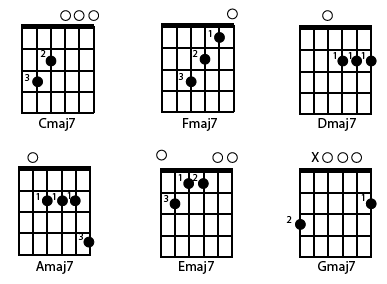All the sevens
After simple major and minor triads, seventh chords are next in line in terms of popularity. They are formed by adding a note that forms an interval a seventh above a chord’s root to the first, third and fifth notes which make up the regular major or minor triad. Sevenths come in three varieties:
1- Dominant seventh

The most common seventh chord in everyday use, particularly in pop, rock, folk and blues, is the ‘dominant’ seventh, called this because it is often (but certainly not always) applied to the dominant (5th) chord in a key. In the key of C major, the dominant seventh would be G7. In F major, it would be C7. The chord consists of a major triad plus a minor seventh note. It has a more edgy, urgent tone than the simple major triad.
I set myself a challenge. How many different dominant seventh chords could I cram into a single track? Here’s the result:
So, how many sevenths did I fit into this track? The answer is 11 out of a possible 12. I just couldn’t find somewhere to put an F#7.
The verse goes like this: D7 G7 C7 F7 D7 G7 C7 A7 / D7 G7 C7 F7 Bb7 Eb7 C7
And the bridge: G7 C7 A7 D7 B7 E7 A7 Ab7 / G7 C7 A7 D7 B7 A7 D7 G7 C7 A7
Strangely, I closed on an Fm.
Instruments used on Rocky Road:
Horns: Session Horns Pro from Native Instruments
Lead guitar: Electric Sunburst from Native Instruments
Acoustic guitar: Picked Acoustic from Native Instruments
Drums: VD-Deep from ujam
Bass: VB-Dandy from ujam
2 – Major seventh

The second type is the major seventh. The chord sounds lush and jazzy, mainly because the major seventh note (B in the example above) is only a semitone away from the chord’s root (C), which creates an attractive dissonance.
Here’s a short sketch which plays around with major sevenths …
I regard the major seventh as my friend, often coming to my rescue to add a little magic to an otherwise mundane composition. It’s commonly found in jazz and more sophisticated soul music but pops up just about everywhere. Strangely, The Beatles very rarely used major sevenths, whereas Paul Simon uses them all the time – just listen to the start of Old Friends …
My short piece above repeats the following chords: Cmaj7 Fmaj7 Em7 Fmaj7. In fact, you’ll often find minor sevenths (the Em7 here) mixed with major seventh in jazz and soul (sometimes they seem to stick a seven on the end of every major and minor chord, just for starters).
Here are some very easy examples of major seventh chords in the first position on the guitar.

There’s a current surge of popularity in major (and minor) sevenths. In The Billboard top 5 as at April 2021 you’ll find Peaches by Justin Bieber and Daniel Caesar (chord progression Fmaj7 Em7 Dm7 Cmaj7) as well as Leave The Door Open by Silk Sonic which oozes major sevenths (main progression Fmaj7 G7 Em7 Am7).
3 – Minor seventh

The third type is the minor seventh, which adds a minor seventh note to the minor triad. Like the major seventh, this chord sounds rich and jazzy although it doesn’t have the inherent dissonance of the major seventh.
Here are some easy examples of minor seventh chords in the first position on the guitar:

The following track, Seventh Prime, deliberately makes liberal use of major and minor sevenths. It starts by ascending the C scale with the chords Cmaj7 Dm7 Em7 Fmaj7.
Instruments on Seventh Prime:
Piano: The Maverick from Native Instruments
Electric Piano: Arturia Stage-73 V Piano
Bass: Mellow Virtual Bassist from ujam
Drums: Studio Drummer from Native Instruments
Horns: Session Horns Pro from Native Instruments
When to use major and minor sevenths
You won’t always improve a composition by enriching your major and minor chords with sevenths. I like this summary by Music Technology Professor, Ethan Hein: “Do you want to sound jazzy and sophisticated? Use sevenths and higher extensions. Do you want to sound populist and direct? Don’t use them. It’s all about stylistic contexts. Using sevenths and other chord extensions will sound pretentious in a Bruce Springsteen song, but not using them will sound awkward in a Cole Porter song.”

